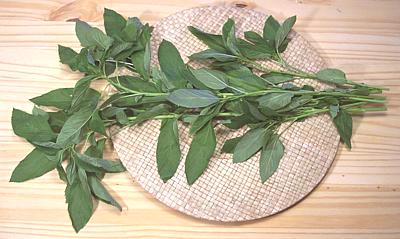 [Egyptian Spinach, Okra Leaf, Mallow Leaf, Jew's Mallow; Saluyot
(Philippine); Molokhia, Mulukhiyah (Arab); Ewedu (Yoruba); Ayoyo (Hausa,
Fulbe); Kerenkere (Igbo); Malta Sag (India); Bai po (Thai);
T. Corchorus olitorius (Middle East, Africa, South & Southeast
Asia) | Corchorus capsularis (Japan, China),
both of subfamily Grewioideae]
[Egyptian Spinach, Okra Leaf, Mallow Leaf, Jew's Mallow; Saluyot
(Philippine); Molokhia, Mulukhiyah (Arab); Ewedu (Yoruba); Ayoyo (Hausa,
Fulbe); Kerenkere (Igbo); Malta Sag (India); Bai po (Thai);
T. Corchorus olitorius (Middle East, Africa, South & Southeast
Asia) | Corchorus capsularis (Japan, China),
both of subfamily Grewioideae]
Fiber of mature molokhiya plants is known as Jute, but for use as food the plant is picked young and cooked as greens. While thought native to India, it has been the most important green in Egyptian cooking since ancient times. Consequently, it's available frozen in stores serving Near Eastern communities In season (Summer months), it's available fresh in Southern California, sold as "Okra Leaf". In Egypt leaves are also dried (they are thin and dry quickly) and are crumbled into a powder for use in teas and soups.
The leaves are quite mucilaginous when cooked. Most Americans would consider them "slimy", but in North Africa and the Levant the effect is much liked. In these regions the most common use is in Chicken stews, particularly with rice.
More on Mallows.
If they have become wilted you can refresh them by cutting the stem ends as for cut flowers, then float the entire fronds in cold water for an hour or so. Just sticking the cut ends in water does no good at all.
Frozen Malokhia can also be found in Philippine markets and markets serving a Levantine or North African community.
Frozen molokhia is almost always already chopped fine. It is generally added to soup while still frozen and stirred a little until completely thawed and the soup is back to a simmer.
mw_molokz 080907 - www.clovegarden.com